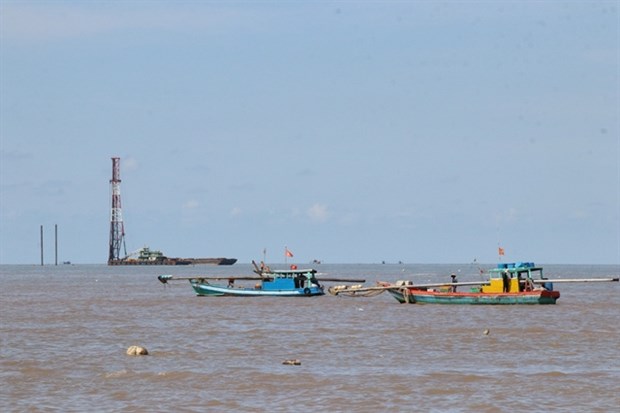Ca Mau aims to become energy centre of Mekong Delta by 2030
The Mekong Delta province of Ca Mau has set a target of becoming an energy centre of the region by 2030.
 Ganh Hao sea gate in Ca Mau (Photo: VNA)
Ganh Hao sea gate in Ca Mau (Photo: VNA)Ca Mau (VNA) - The Mekong
Delta province of Ca Mau has set a target of becoming an energy
centre of the region by 2030.
The province seeks to raise total electricity generation capacity of local power plants of all kinds to 4,000MW by 2030, including 1,000MW of renewable power, and to 5,000MW by 2045.
It plans to invest in new gas-storage facilities, gas filling and supply stations, floating storages, gas recycling stations and gas pipelines. It would import and store about 7 million cubic metres of liquefied natural gas (LNG) per year from 2030 and 10 million cubic metres from 2045.
Investment in electricity generation, transmission and distribution infrastructure will also be required.
Programmes on efficient energy use and reduction of power losses will continue. The province targets saving at least 7 percent of total energy consumption each year by 2030, and 14 percent by 2045.
Investment priorities will be for wind, solar, gas and thermal power.
The province is calling for investment in gas and liquefied natural gas (LNG)-fired power plants, which will help meet electricity demand and supply of petroleum products in the province and neighbouring provinces.
It will also build Floating Storage and Regasification Units (FSRUs) systems to ensure the supply of imported LNG to power plants in the province and the region.
Experts have urged the province to speed up the construction of wind and solar power projects.
Ca Mau is developing specific policies to encourage investment in power plants that use urban waste, biomass and solid waste to generate electricity.
It is giving priority to production of renewable energy such as wind and solar power, and will invest in studying and evaluating the potential for development of new renewable sources.
Rooftop solar power projects, and projects combining aquaculture and solar power systems on water surface or in coastal areas are also being encouraged.
The province will offer support to help investors develop offshore wind power projects, which is in line with the province's tourism and marine economic development strategy.
Investment will also be sought for LNG projects with floating storage systems at sea, and power projects using rice straw, urban waste, biomass and solid waste.
The province is encouraging the private sector to take part in energy development, train high-quality human resources for the energy sector, reduce greenhouse gas emissions, and increase the use of clean and renewable energy.
The southernmost province of Ca Mau has a coastline of more than 250km./.
The province seeks to raise total electricity generation capacity of local power plants of all kinds to 4,000MW by 2030, including 1,000MW of renewable power, and to 5,000MW by 2045.
It plans to invest in new gas-storage facilities, gas filling and supply stations, floating storages, gas recycling stations and gas pipelines. It would import and store about 7 million cubic metres of liquefied natural gas (LNG) per year from 2030 and 10 million cubic metres from 2045.
Investment in electricity generation, transmission and distribution infrastructure will also be required.
Programmes on efficient energy use and reduction of power losses will continue. The province targets saving at least 7 percent of total energy consumption each year by 2030, and 14 percent by 2045.
Investment priorities will be for wind, solar, gas and thermal power.
The province is calling for investment in gas and liquefied natural gas (LNG)-fired power plants, which will help meet electricity demand and supply of petroleum products in the province and neighbouring provinces.
It will also build Floating Storage and Regasification Units (FSRUs) systems to ensure the supply of imported LNG to power plants in the province and the region.
Experts have urged the province to speed up the construction of wind and solar power projects.
Ca Mau is developing specific policies to encourage investment in power plants that use urban waste, biomass and solid waste to generate electricity.
It is giving priority to production of renewable energy such as wind and solar power, and will invest in studying and evaluating the potential for development of new renewable sources.
Rooftop solar power projects, and projects combining aquaculture and solar power systems on water surface or in coastal areas are also being encouraged.
The province will offer support to help investors develop offshore wind power projects, which is in line with the province's tourism and marine economic development strategy.
Investment will also be sought for LNG projects with floating storage systems at sea, and power projects using rice straw, urban waste, biomass and solid waste.
The province is encouraging the private sector to take part in energy development, train high-quality human resources for the energy sector, reduce greenhouse gas emissions, and increase the use of clean and renewable energy.
The southernmost province of Ca Mau has a coastline of more than 250km./.













